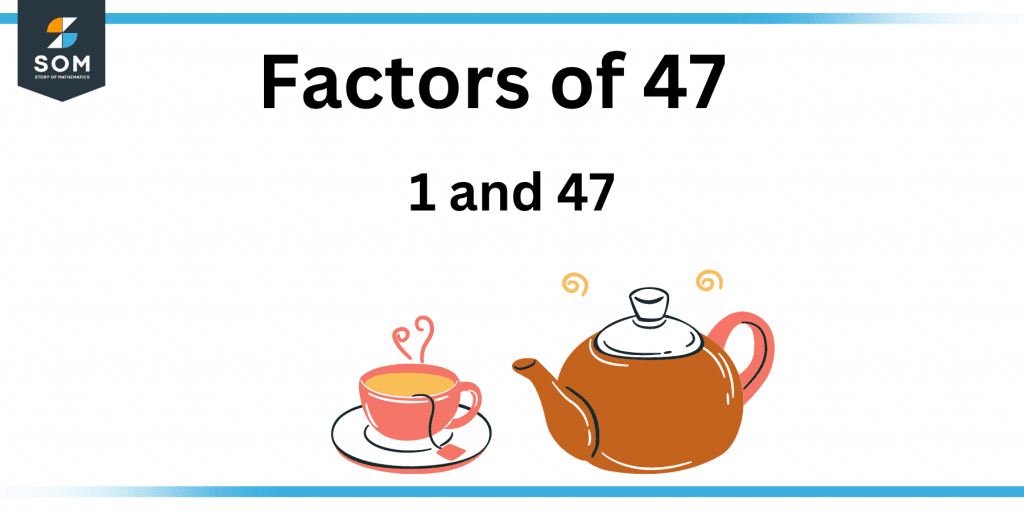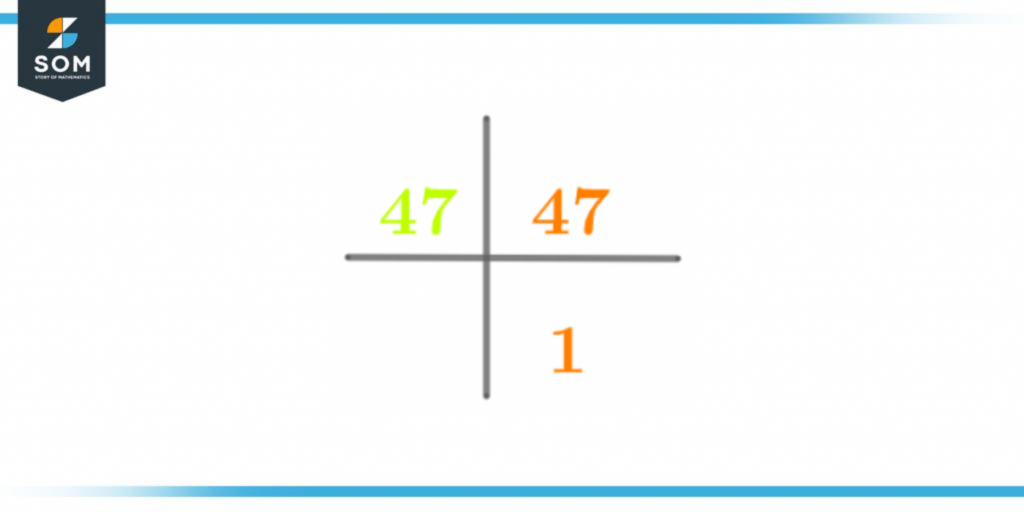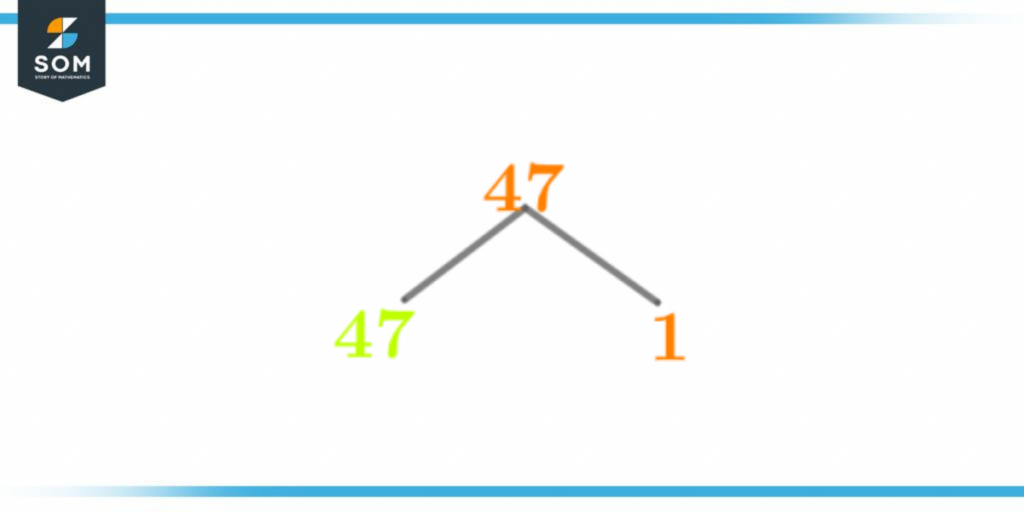JUMP TO TOPIC
Factors of 47: Prime Factorization, Methods, Tree, and Examples
The factors of 47 are the numbers upon which the number 47 can be divided as a whole. Regarding division, the factors of 47 are defined as those numbers which produce a zero remainder and whole number quotient when 47 is divided from them.
Figure 1 – All possible Factors of 47
What Are the Factors of 47?
The factors of 47 are 1 and 47. These two numbers are the special divisors upon which the number 47 is completely divisible. The number 47 has a total of 2 factors as it is a prime number. These two factors can form a single factor pair. They are positive as well as negative.How To Calculate the Factors of 47?
You can calculate the factors of 47 through the division method. The division method is one of the easiest methods which can be implemented for determining the factors of any number.As the name suggests, the division method is based on the principle of division. In this method, the number acts as the dividend, and the potential factors serve as the divisors. The condition for the division method is that if the divisor produces the remainder as zero and produces a whole number quotient, then this indicates that the potential divisor acts as the factor.A general rule for factors is that the smallest factor is always one, and the most significant factor is the number itself. So the same applies to the number 47 itself. Moreover, the number 47 is a prime number, so this automatically means that the number will only have two factors.Combining the two statements above leads to the fact that the two factors 47 will have are the smallest factor 1 and the number 47 itself.The application of the division method to the number 47 is shown below:\[ \frac{47}{1} = 47 \]\[ \frac{47}{47} = 1 \]So the factors of 47 are given below:Factors of 47 = 1 and 47As the factors of 47 are natural numbers, they will have two sides – one positive side and the other negative side. So this implies that the factors of 47 are negative numbers as well. The negative factors of the number 47 are given below:Negative Factors of 47 = -1 and -47Factors of 47 by Prime Factorization
Prime factorization is a division-based technique to evaluate any number’s prime factors. The factors of any number can be both composite numbers as well as prime numbers. The prime numbers which act as the factors are called prime factors. The prime factorization method is used to find these prime factors.In prime factorization, the number itself acts as the dividend, and the prime numbers act as the divisors. The prime numbers carry out the division process. This division continues until the number 1 is the only thing left at the end.As the number 47 is a prime number, the factors it will have will also be prime numbers. The prime factorization of 47 is shown below:47 $\div$ 47 = 1
So the prime factorization of 47 has the following mathematical expression:Prime Factorization of 47 = 1 x 47
This prime factorization is also shown in the figure given below:
Figure 2 – Prime Factorization of 47
Prime Factors of 47 = 47
Factor Tree of 47
A factor tree is a mathematical structure that shows a number’s prime factors. Since it depicts the prime factors of a number, it can also be stated that prime factorization can be visually represented in the form of a factor tree.The factor tree begins with the number itself as the root number and splits it into two branches. One of these branches holds a prime number. Hence, a prime factor and the other brand holds the whole number quotient.This quotient takes the root number’s place and splits it into two branches. This process of splitting into branches continues until only prime numbers are left at the terminating branches of the factor tree. The factor tree for the number 47 is given below:
Figure 3 – Factor Tree of 47
Factors of 47 in Pairs
The factors of 47 also tend to exist in the form of pairs known as factor pairs. As the name suggests, a factor pair consists of a pair of numbers. This pair of numbers need to be factors of the original number and produce the actual number upon multiplication.47 is a prime number, so it only consists of 2 factors. These two factors form a single factor pair. This factor pair is given below:1 x 47 = 47
The factor pair is written as:Factor Pair of 47 = (1, 47)Another condition for the factor pair is that the two numbers within a factor pair must share the same sign. In the case of positive factors, both numbers need to have a positive sign; in the case of negative numbers, both numbers must have a negative sign.This is so they could give a positive result as the result of multiplication.The negative factor pair is given below:-1 x -47 = 47
Negative Factor Pair of 47 = (-1, -47)Factors of 47 Solved Examples
Up until now, we have covered all the various methods which can be utilized for determining the factors of 47. Now let’s move on to some solved examples incorporating these factors of 47.Example 1
Determine the sum of the factors of 47 and find out if the resulting number is a multiple of 2 or 3.Solution
Before we move on to the solution of this example, let’s first list the factors of 47. The factors of 47 are:Factors of 47 = 1 and 47Now let’s calculate the sum of these factors. The sum of the factors of 47 is given below:Sum of factors of 47 = 1 + 47
Sum of factors of 47 = 48
Now let’s determine if this number is a multiple of 2 or 3. The number 48 is an even number, indicating that the number 48 is a multiple of 2. This is evident from the multiplication method, which is given below:2 x 24 = 48
Now let’s evaluate whether or not the number 48 is a multiple of 3. An easy way to do so is to calculate the sum of the digits of the number 48 and check if the resulting number is a multiple of 3.As the sum of the digits of 48 is 4 + 8 = 12, and as the number 12 is a multiple of 3, it is evident that 48 is also a multiple of 3.3 x 16 = 48
Hence, the number 48 is a multiple of the numbers 2 and 3.Example 2
Calculate the average of all the factors of 47.Solution
For determining the average of factors of 47, let’s first take a look at these factors.Factors of 47 = 1 and 47The formula for average is given below:\[ Average = \frac{\text{Sum of all factors of 47}}{\text{Total number of factors of 47}} \]\[ Average = \frac{1 + 47}{2} \]\[ Average = \frac{48}{2} \]Average = 24
Hence, the average of all the factors of 47 is 24.All images/mathematical drawings are created with GeoGebra.